| 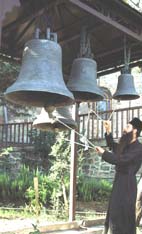
In Russia, church bell peals are fixed as in carillons but played by a single person in patterns reminiscent of change ringing.

Change ringing peal in the Swan Bells tower, Perth, Australia
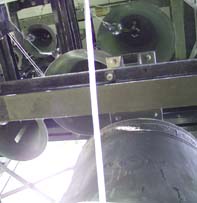
Carillon bells at Iowa State University, Ames, USA
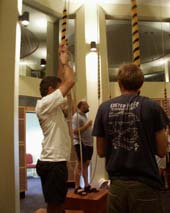
The ringers room in the Swan Bells tower.
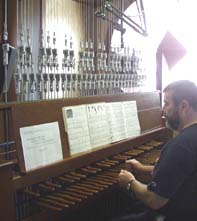
Carillon playing manual at Ames
|
The two principal traditions of bell-ringing in Western countries are change ringing found in England andCommonwealth countries, and carillons which are found largely on the Continent and in America.
Change ringing involves from 6 to as many as 16 bells played by a team of people. The bells are played in compositions in which no sequence (passage containing one strike of each bell) is repeated during a peal. The bells in change ringing peals are usually tuned to a diatonic Western scale such an C major. They are suspended in rotating frames that spin through 360 degrees when a rope is pulled (full circle ringing). This produces the sound of Church bell pealing that is so familiar to people in Commonwealth countries.
One of the features of change ringing bell sounds is the Doppler effect. This is a varying pitch shift caused by the mouth of the bell swinging towards and away from the listner with each stroke. Another important aspect of the sound of full circle ringing is the rapid damping of each bell sound by the clapper at the end of the swing.
In carillons the bells are fixed to their supporting frame and clappers are pulled against them by wires attached to a playing manual, not unlike an organ keyboard. Since musical compositions involving modulation are played on carillons, at least two octaves of chromatically tuned bells are usually needed. This mode of playing bells is not as loud as change ringing and the pitch of each bell is better defined due to the absence of the Doppler effect.
An aspect of bell-ringing common to both modes in the West is a looseness of rhythmic accuracy. This is due to the physical difficulty involved in ringing the bells, and is a consequence of the rich relationship between the bell and the player that makes bell-ringing so fascinating to the proponents of the art.
CASTING
There five well-known foundries producing tuned bells in Europe. They are Taylor's and Whitechapel in England, Eisbouts and Petit and Fritsen in Holland and Packard in France. Bellcasting techniques in Europe have changed little over hundreds of years. English foundries use loams made from horse manure and clay for the inside and outside mould shapes. The shapes are made using a profile cut in timber on a turntable. When these mould shapes are assembled they create the empty volume into which the metal is poured.
Dutch foundries make the inside mould (core) in a similar manner, but then turn up a wax bell over the core (called a false bell). The false bell bell is then decorated with wax adornments and then invested in moulding material. The wax is burnt out of the mould in a kiln before casting the bell.
Loam moulds must be dried repeatedly in a large oven before being used. Shrinkage and cracking of the moulds, and residual moisture are associated problems with traditional bell moulding processes. Most of the developments in bell making have been in the tuning of bells with modern lathes after they have been cast oversize.
NEW DESIGNS
While Australian Bell can supply European church and carillon bells from the European bell-foundries, Australian Bell has also designed European style bells with both minor and major third tunings. The famous Hemony bell profile has been used as starting point to tune the first 5 partials in a standard English minor third tuning. This bell is significantly lighter than most modern bells of the same pitch and may be ideal for older towers that cannot otherwise support the weight of a peal. One of these bells has been cast and tuned for the Federation Bell installation. Thicker walled minor and major third patterns are also available.
Australian Bell can quote on the supply of or the casting of European bells and in collaboration with international bell companies design, manufacture and install bell support structures and operating systems for all bell projects.
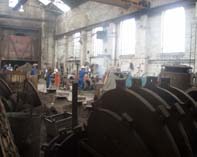 |
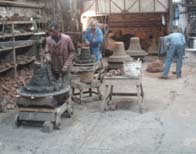 |
| Pouring bells at Taylor's Foundry, UK |
Preparing mould cores at Whitechapel Foundry, UK |
|

.jpg)

.jpg)